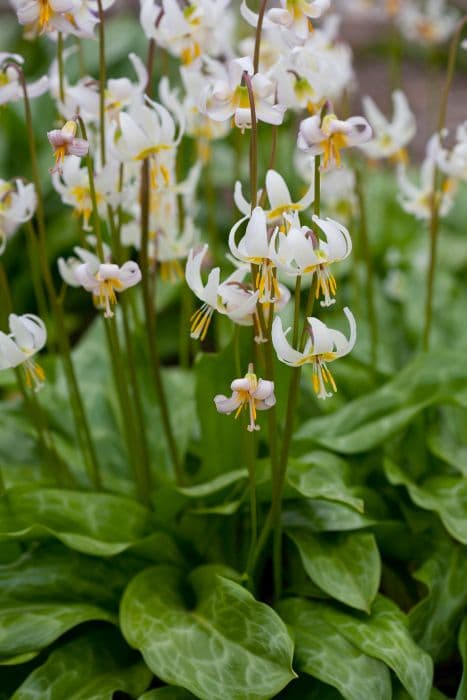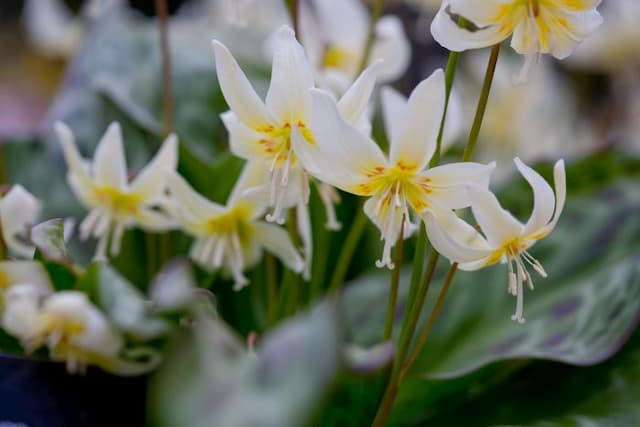Toad Lily Tricyrtis hirta

ABOUT
Tricyrtis hirta, commonly known as toad lily, is a plant that is admired for its unique and striking appearance. The toad lily is characterized by its beautiful, intricate flowers which boast a mesmerizing combination of colors and patterns. Each bloom consists of six petal-like segments that are typically white or cream-colored, providing a delicate background for an array of speckles and spots in deep purple to mauve. The center of the flowers is often a yellowish color with a touch of the same darker speckling, giving it a spotted toad-like appearance, hence the name. The flowers have a somewhat orchid-like look and grow in small clusters. Each bloom has prominent, showy stamens that extend outward, adding to the ornamental value of the plant. These flowers are situated at the top of arching stems, surrounded by lush green leaves. The foliage of the toad lily is also quite attractive, with leaves that are long, narrow, and pointed, often having a slightly hairy or textured surface. These leaves may form a spiraling pattern as they ascend the stems, providing a nice contrast to the delicate flowers. Overall, the toad lily strikes a balance between its handsome foliage and enchanting flowers, making it a distinctive and highly desirable plant for shady gardens and woodland settings. It delivers a visually pleasing display when many other plants are concluding their blooming season, providing continued interest in the garden through its flowering period.
About this plant
 Names
NamesFamily
Liliaceae
Synonyms
Toad Lily, Hairy Toad Lily, Japanese Toad Lily
Common names
Tricyrtis hirta.
 Toxicity
ToxicityTo humans
Toad lily (Tricyrtis hirta) is generally considered not toxic to humans. However, as with many plants, individual reactions can vary, and it is always prudent to prevent children from ingesting any plant material due to the potential for unforeseen allergies or reactions. There is no significant indication that the toad lily is poisonous, and there are no well-documented cases of poisoning from this plant. Therefore, no specific symptoms of poisoning are noted. However, if any part of the plant is ingested and an adverse reaction is observed, medical advice should be sought.
To pets
Toad lily (Tricyrtis hirta) is not commonly listed as a toxic plant to pets such as dogs and cats. As with its effects on humans, there is no significant evidence that ingestion of any part of the toad lily plant causes poisoning in pets. However, it is advisable to keep an eye on pets to prevent them from eating plants, as individual animals may have different responses or sensitivities. If any part of the plant is ingested by a pet and a negative reaction occurs, it is recommended to consult a veterinarian.
 Characteristics
CharacteristicsLife cycle
Perennials
Foliage type
Deciduous
Color of leaves
Green
Flower color
Mixed
Height
2-3 feet (60-90 cm)
Spread
1-2 feet (30-60 cm)
Plant type
Herb
Hardiness zones
5
Native area
Japan
Benefits
 General Benefits
General Benefits- Aesthetic Appeal: Tricyrtis hirta, commonly known as Toad Lily, has unique, speckled flowers that add visual interest to garden landscapes, especially in shaded areas.
- Late Bloomer: Toad lilies offer late-season blooms when many other plants have finished flowering, extending the garden's visual appeal into the fall.
- Shade Tolerance: They thrive in partial to full shade, making them ideal for woodland gardens and shady borders where other flowers might struggle to grow.
- Drought Resistance: Once established, Toad Lilies are relatively drought-tolerant, requiring less watering compared to other shade-loving plants.
- Pest and Disease Resistance: Tricyrtis hirta is generally resistant to pests and diseases, reducing the need for chemical treatments in the garden.
- Wildlife Attraction: The flowers attract pollinators, such as bees, contributing to the health of the garden ecosystem.
- Low Maintenance: Toad Lilies are considered low maintenance, requiring minimal care once they are established in the appropriate location.
- Versatility in Landscaping: They can be used in a variety of garden styles, including woodland, cottage, and naturalized areas.
 Medical Properties
Medical Properties- This plant is not used for medical purposes.
 Air-purifying Qualities
Air-purifying QualitiesThis plant is not specifically known for air purifying qualities.
 Other Uses
Other Uses- Ink Production: The spotted and vivid patterns of toad lily flowers can be used as inspiration for natural ink or dye, creating a unique botanical print for arts and crafts.
- Garden Design: Toad lilies provide an aesthetic design element in shade gardens or woodland gardens, contributing color and texture during late summer and fall.
- Photography Subject: Their intricate flowers make them a favorite for photographers looking to capture the detail and beauty of unique floral specimens.
- Educational Tool: Toad lilies can be used in educational settings to teach about pollination and the ecological significance of unique flower structures.
- Culinary Garnish: Although not commonly eaten, the decorative flowers could potentially be used as a non-toxic garnish to add visual interest to culinary presentations.
- Bee Gardening: They can be included in bee-friendly gardens to provide a late-season nectar source for bees and other pollinators.
- Fairy Gardens: Their whimsical flower appearance makes them suitable for fairy gardens and other imaginative garden themes for children.
- Textile Patterns: The intricate patterns of the toad lily flowers can inspire textile designs for fabrics, wallpapers, or wrapping papers.
- Water Features: Toad lilies, being moisture-loving plants, can be planted around ponds or water features to create a naturalistic setting.
- Container Gardening: Suited for container gardening, toad lilies can decorate patios or balconies where ground space is limited.
Interesting Facts
 Feng Shui
Feng ShuiThe Toad Lily is not used in Feng Shui practice.
 Zodiac Sign Compitability
Zodiac Sign CompitabilityThe Toad Lily is not used in astrology practice.
 Plant Symbolism
Plant Symbolism- Overcoming Challenges: Tricyrtis hirta, commonly known as toad lily, often blooms in the late summer to early fall when many other flowers have passed their peak, symbolizing resilience and the ability to thrive in adverse conditions.
- Uniqueness: With its unique spotted petals, the toad lily stands out from common garden flowers, representing the celebration of individuality and uniqueness.
- Exotic Beauty: Native to Asia and often found in shaded, woodland settings, the toad lily's intricate and exotic-looking blossoms can symbolize the appreciation of beauty in all forms, especially that which is unexpected or untraditional.
- Opportunity: As a plant that blossoms in the later part of the year, the toad lily can represent making the most of opportunities, even those that come later in life or at unexpected times.
 Water
WaterToad lily plants should be watered deeply once a week, providing about one inch of water which roughly translates to about 0.6 gallons per square yard of soil. Ensure that the soil is kept consistently moist but not waterlogged. In periods of drought or extreme heat, increase watering frequency to maintain soil moisture. During the winter months when the plant is dormant, reduce watering to prevent root rot. It's crucial to avoid overhead watering to minimize the risk of leaf diseases, instead water at the base of the plant.
 Light
LightToad lilies thrive in partial to full shade, preferring a spot that receives dappled sunlight or light shade throughout the day. An ideal location would be under the canopy of trees or on the north side of a building where harsh direct sunlight is avoided. These conditions simulate their natural habitat in the woodland understory, and will help prevent the leaves from scorching.
 Temperature
TemperatureToad lilies are hardy in temperatures down to about 5°F and can tolerate highs up to about 85°F. Their ideal growing temperatures are between 50°F to 75°F, which encourages healthy growth and flowering. They should be protected from extreme heat and harsh frost to ensure their perennial return.
 Pruning
PruningToad lilies benefit from pruning to remove dead or damaged foliage, which encourages healthy growth and can prevent disease. The best time to prune is in the spring before new growth starts, or in the late fall after the plant has finished blooming. Cut back to just above a set of leaves for best results. Deadheading spent flowers will help promote further blooming.
 Cleaning
CleaningAs needed
 Soil
SoilToad Lily thrives in organically rich, moist, well-draining soil with a slightly acidic to neutral pH of 6.1 to 7.0. A good mix can be made from equal parts of loamy soil, peat moss or compost, and perlite or pine bark for drainage.
 Repotting
RepottingToad Lily plants should be repotted every two to three years, or when they outgrow their current pot. It's best done in the spring before the onset of the growing season.
 Humidity & Misting
Humidity & MistingToad Lilies prefer high humidity conditions, ideally between 60% to 80%. Providing extra humidity can be beneficial, especially when grown indoors.
 Suitable locations
Suitable locationsIndoor
Keep Toad Lily in bright, indirect light with high humidity.
Outdoor
Plant Toad Lily in partial shade, moist soil, and mulch.
Hardiness zone
Toad Lily is suitable for USDA 4-9.
 Life cycle
Life cycleTricyrtis hirta, commonly known as Toad Lily, begins its life cycle when seeds germinate in spring after overwintering or when fresh seeds are sown after ripening. Seedlings develop into rosettes of green, lance-shaped leaves on arching stems, which mature through the first growing season. In subsequent years, the plant grows back from its perennial roots, with stems elongating and leaves expanding as the plant establishes. By late summer to early fall, the Toad Lily reaches flowering maturity, producing small, orchid-like flowers that are often speckled and come in shades of purple, white, or pink. After flowering, the plant sets seed in capsules that, once dried, release seeds to propagate the next generation. With the arrival of winter, the above-ground parts of Toad Lily die back, with the plant's root system surviving the cold to regrow in the next cycle.
 Propogation
PropogationPropogation time
Late summer
Propogation: The Toad Lily (Tricyrtis hirta) is commonly propagated through division, a process best done in the spring. To propagate by division, carefully dig up a well-established Toad Lily clump after the danger of frost has passed and the soil can be worked. Gently separate the clump into smaller sections, making sure each section has at least one growth point or shoot. These sections can then be replanted in well-prepared soil, ensuring they are spaced at least 18 inches (approximately 45 centimeters) apart to allow room for growth. Water the newly planted divisions thoroughly to help establish them in their new location. This method is effective as it maintains the genetic consistency of the parent plant and provides a relatively quick means to expand the garden's display of these unique flowers.








